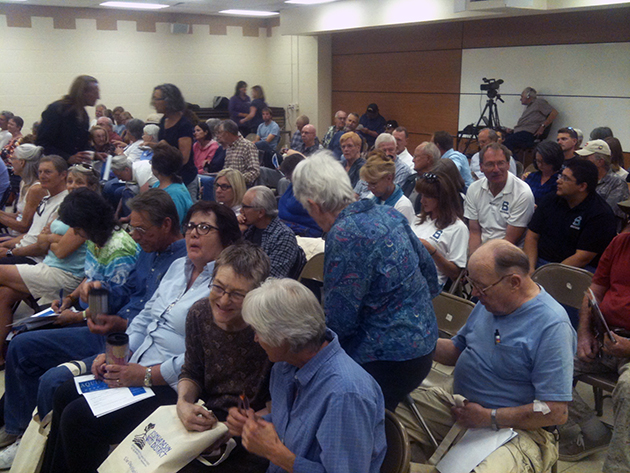18.4.14

We were a pack of over a hundred today, all piled in to the windowless cinderblock room. This seemingly unassuming space is actually a vibrant community center for watching children’s theatre group plays, the annual gem and mineral show, and meetings about pressing issues the community is facing, like the meeting I went to: Aquifers 101. I came out of desperation, wanting to know when the water is going to be gone. The answers to this question extend beyond the boundaries of Joshua Tree. What is happening here is a future image of what the world over is about to undergo.
The fault lines of the scientist’s forehead wrinkled and unwrinkled as he clarified: there are no underground lakes below this desert. The aquifers below the sand are not lakes but actually water that has seeped into the interconnected pores of rocks and alluvium and accumulated over impermeable substrate. Joshua Tree sits on the Joshua Subbasin, a narrow three-storied aquifer 2,000-4,500 feet deep—a wet sponge of sand and gravel shaped like a valley partially paved over with Highway 62. Over 99% of the water drawn out each year in the Joshua Subbasin is from stored water accumulated over centuries. Only 1% of the water is replenished by annual rainfall and underflow. The natural recharge of Joshua Tree is 207 acre feet per year, 84 come from underflow from the Warren Subbasin to the west and 123 come from rainfall and streamflow. Each year, Joshua Tree uses 1,612 acre feet (525,465,083 gallons). Drinking water is going to run out, just when is unknown. 30 years? 100 years? It depends on a lot of factors: the increase in people moving here sucking the aquifers dry like vampires with wells for fangs; the increase in oases of globalization receiving intravenous injections by roads and parking lots refusing to let the water permeate the ground—but even without any new “development” the current amount of water extraction is beyond what the system can sustain. I admire the people who aren’t hedging their bets over whether or not it will be their problem to deal with, the people who want to do something whether or not they will be above or below ground when the drinking water is gone.
But really, the water will never run out. Before attempting the impossible act of squeezing every last drop out of the rocks’ pores, the water will become too poor to drink. The present births the process of sucking away the high quality water near the surface, the future bears drawdown and cones of depression sinking straws into the deeper, poorer quality water stored in the lower aquifers. Between the 1950s and 1990s the water level sank 35 feet away from the hearts of homesteaders that have proved up parcels here since 1836, 35 feet away from the roots of plants that feed the scaled, shelled, winged, furred and even the single celled.
Before riding this bomb down into swimming pools and golf courses, the Water District is trying their hand at stop gap measures including aquifer recharge: conjuring water from Northern California down a quagmire of aqueducts and pipes into the Mojave Desert, dumping into recharge ponds to percolate down into the aquifers, carrying unintended consequences with it. When the recharge pond is near a septic system, the water carries septage nitrates down. When the nitrates eventually reach the groundwater, they will become part of the drinking water. Upon entering the bloodstream, nitrates replace oxygen, turning babies blue and acidifying the ecosystems inside stomachs. According to the EPA’s website, the maximum contaminant level of nitrate in drinking water is 10 parts per million (10 milligrams per liter of water). According to the Joshua Basin Water District Water Quality Report, the nitrate level in the drinking water is 16 parts per million and the maximum contaminant level is listed at 45 parts per million.
This isn’t news to the people who have unfolded their lives here. It isn’t unique to Joshua Tree either. The natural materials we call “resources” are being picked clean. Some of us have the luxury to neatly fold up our lives, pack them into suitcases and carry them away in search of other lands. Others can only ball up a few tattered items into a backpack or run away from rifle sites with nothing at all, crossing the land on foot at night, driving by day crammed twelve people into eight person vans and cargo trucks so full no one can sit down, crossing the Aegean Sea in four person life rafts sinking under the weight of twenty people, capsizing reaching shore and rescuing two small boys swallowed by the waves—their mother crushed into the rocks, tossed into a room for three months straight with everyone starving and fighting over any food that is brought, finally reaching the European Union to apply for asylum and be deported back…back to the laser shows of rifle sites, the hum of drones, the flutter of pages turning in torture manuals, the gentle touch of soft power, the spine cracking of structural violence, the slamming of a rifle butt into the back of the skull, the chatter of human cages, the echoes of accusations, the heavy breathing of persecutions and the deafness of bombings.

Katherine Ball was in residence as our HDTS Scout in Spring 2014.
The HDTS Scout Residency is dedicated to learning more about the people and places that make up our diverse and ever evolving community.
Originally from Detroit, Michigan, Katherine has worked on projects around the world, exploring alternatives to the dominant discourse. Some of these include: bicycling across the US to interview Americans working on small-scale solutions to the climate crisis, coordinating a national day of action to halt business at banks and corporations unduly influencing state laws, living in an off-grid floating island building mushroom filters to clean a polluted lake, and studying the behaviors of various species acting as the ecological counterpart to civil disobedience. An amateur in the best sense of the word, Katherine strives to give more energy to our dreams than our fears.
During her residency, Katherine engaged in a series of in-depth interviews and conversations with high desert residents, focusing on our human impact on the desert landscape. Her book represents a condensed version of those discussions, encompassing water conservation, big solar, wildlife linkages, and asks: what is a sustainable life in the desert?










